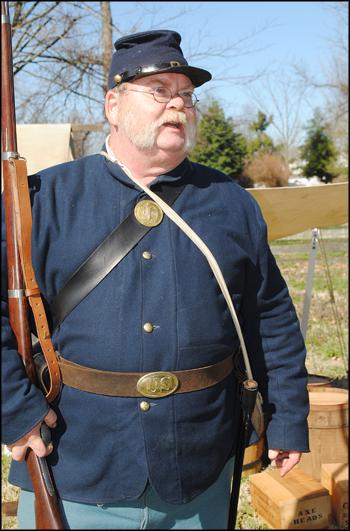
By Annabeth Miller,
ShowMe Times Editor
NEW MADRID - In the early part of 1862, the Union General John Pope was one the move.
The West Point graduate and career Army officer had been summoned on Feb. 14 and given orders to capture a small town and river island in Southeast Missouri. So Pope and his troops headed south from St. Louis, reaching Commerce by Feb, 21. But their ultimate destination wasn’t Commerce – but New Madrid and Island No. 10.
On March 10, Pope began a siege on the Bootheel community that would last until the Confederates surrendered on April 8. Pope and his officers occupied for his heaquarters what was certainly one of the most elegant homes in New Madrid and the Bootheel – the home of Amanda Hunter and her seven children.
The city was once again “invaded” by Union troops, to mark the 150th anniversary of the siege. Re-enactors portrayed Company C of the 47th Illinois Infantry, who served as Pope’s escort company. The re-enactment event was held March 10-11.
After a hearty breakfast on Saturday morning, most of the troops were on a march around New Madrid – looking for Confederates. And almost-empty camp was left behind – with morning fires left banked to take the edge off the morning chill.
Left behind was one private – who said he was the “oldest, fattest private in the Union Army.” But he was chatty, and helped explain the encampment – and the equipment carried everyday by enlisted men.
“It got cold out here last night – I didn’t sleep real good. But one of the men did say he heard me snore,” he explained.
Taste Of History
Steve and Becky LaBarre were busy throughout the morning. Having prepared a hearty breakfast for the 35 or so soldiers that morning, they turned right around and began preparation for the noon meal. Actually, LaBarre said there would be two noon meals to prepare.
“We prepare one meal for the enlisted men, and something else for the officers,” he explained while turning beefsteak in cast iron skillets over the wood fire. That day he was preparing a beef stew for the enlisted men, and steak with root vegetables for the officers.
“The root vegetables would have come out of cellars here,” he explained. The troops would have procured what was needed – vegetables, seasonings, a cow that would have been butchered – from the local residents. Steel pots hung over the low burning fire with the stew and the vegetables for the officer’s meal. Coffee pot sat to the side of the fire.
Becky showed her kitchen and explained the recipes they used throughout the weekend were from the 1860s. She had a big wooden bowl, filled with thick slices of fresh baked bread. Pickles were in blue canning jars, spices in pots and containers.
For instance, the beefsteak Steve was preparing had been rubbed in a dry mustard and fried in the cast iron skillets; a gravy was made using the drippings and coffee, and a garnish was made from English walnuts marinated in sweet pickle juice. All of this was served surrounded by potatoes, parsnips, onions and carrots.
Enlisted men ate from the mess kits; officers had the fine bone china that would have been taken from the Hunter-Dawson home.
Throughout the day the re-enactors drilled and had inspections, and even arrested a few local Confederate sympathizers.
Hunter-Dawson Home
Next door, tours were given of the Hunter-Dawson home. The home was built by William and Amanda Hunter, a Virginian who moved to the area in 1830, became a successful businessman and acquired a large section of land north of the town.
The Hunter-Dawson house is a two-story, 15-room frame structure of an eclectic style with Georgian, Greek Revival and Italianate influences. The lumber used in the house is yellow cypress, which s came from a nearby sawmill owned by Hunter. The labor during construction was furnished by Hunter's own slaves and by area craftsmen.
The home has a basement, and family tradition says that some local Confederate soldiers, injured in skirmishes before Pope occupied the home, hid in the basement. Local ladies slipped the men food and medical supplies by hiding them under their skirts. The ladies would stroll the grounds, stand at the basement windows, and the men would reach under the full skirts for the needed supplies!
William never lived in the home; he died from yellow fever in 1859. Portraits of William and Amanda hang in the parlor.
Amanda and William’s descendants gave the home and the furnishings for a state historic site in 1966. The home is grand – with 15 rooms, nine fireplaces, and furnishings.
In observance of the 150th anniversary of the War Between The States, this report is part of periodic series on Civil War sites in our region.
Sites Of Interest
ShowMe Times Photo Gallery
ShowMe Times Photos by Annabeth Miller

